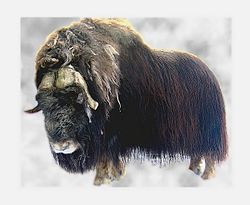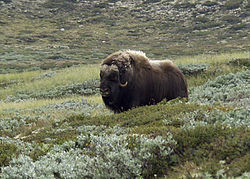Musk ox
The musk ox (Ovibos moschatus, muskox) is a large Arctic mammal of the Bovidae family.
| Musk ox | |
|---|---|

| |
| Conservation status | |
| Scientific classification | |
| Kingdom: | |
| Class: | |
| Order: | |
| Family: | |
| Subfamily: | |
| Genus: | Ovibos Blainville, 1816
|
| Binomial name | |
| Ovibos moschatus (Zimmermann, 1780)
| |

| |
| Range map. Blue indicates areas where the muskox has been successfully introduced in the 20th century. Red indicates established range. | |
It has a thick coat, and was common in the northern hemisphere during the Pleistocene ice age. The males give off a strong odour, hence its name. This musky odour is used to attract females during mating season. Musk oxen travel in herds of females and their young led by one or two strong males. Male oxen fight over who will be leader by butting their thick heads and horns against each other. The musk oxen's long, curved horns keep away predators. When a herd smells nearby wolves, all the musk oxen form a circle and face out. They lower their heads to show off their horns.[2]
Musk oxen live in the Arctic, North America and Greenland,[3] with small introduced populations in Sweden, Siberia and Norway.
Musk oxen are herbivores which graze on grasses, leaves, and some Arctic flowers. They are ruminants; they swallow their food without chewing it. Later, they regurgitate the food (called a cud) and chew it. Musk oxen, like other ruminants, have a stomach with four sections.
Fossil DNA evidence suggests musk oxen were not only more geographically widespread during the Pleistocene, but also more genetically diverse.[4] During that time, other populations of musk oxen lived across the Arctic, from the Ural Mountains to Greenland. Together with the bison and the pronghorn,[5] the muskox was one of a few species of Pleistocene megafauna in North America to survive the Pleistocene/Holocene extinction event and live to the present day.[6]
Musk Ox Media
Euceratherium skeleton (missing its ribs)
Muskox at Cape Krusenstern National Monument, Alaska
Muskox family in east Greenland
Male in Dovrefjell–Sunndalsfjella National Park, Norway
Nunivak Island, Alaskan muskoxen in the 1930s, shown here in defensive formation
Muskox in Dovrefjell-Sunndalsfjella National Park, Norway
Muskox on Bolshoy Begichev Island, Russia
References
- ↑ Gunn, A. & Forchhammer, M. (2008). Ovibos moschatus. 2008 IUCN Red List of Threatened Species. IUCN 2008. Retrieved on 31 March 2009. Database entry includes a brief justification of why this species is of least concern.
- ↑ Cole, Joanna (2000). The Magic School Bus, Polar Bear Patrol. U.S.A. ISBN 0-439-31433-X.
- ↑ Greenland guide. Animal Life in Greenland - an introduction by the tourist board Archived 2012-04-27 at the Wayback Machine
- ↑ "Muskox suffered loss of genetic diversity at Pleistocene/Holocene transition". Science Daily. 2005-10-06. Retrieved 2011-03-03.
- ↑ Smithsonian Institution. North American Mammals: Pronghorn Antilocapra americana Archived 2016-01-22 at the Wayback Machine
- ↑ Switek, Brian. "Prehistoric DNA reveals the story of a Pleistocene survivor, the Muskox." Laelaps blog on Science Blogs, posted 10 Mar. 2010. Accessed 18 Jan. 2013.








